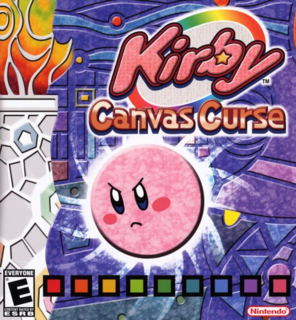Canvas Curse is the most rewarding Kirby game ever made and an essential Nintendo DS experience.
In Canvas Curse, the Kirby series maintains its vibrant and colorful visual style while successfully taking advantage of the DS's touch-screen capabilities. The result is a Kirby game that takes the series to new territories and manages to be something that Kirby games usually are not; challenging. Impressive extras and challenges add to a solid campaign, making Canvas Curse the most rewarding Kirby game ever made and an essential Nintendo DS experience.
The controls in Kirby's first DS adventure revolve exclusively around the touch screen. Kirby is literally a little pink puff ball in Canvas Curse. He maintains his power copying abilities though his sucking abilities are gone. Players must stun enemies by tapping them with the stylus, and when Kirby rolls into a stunned enemy, he gains that enemy's ability if it has one. Tapping Kirby causes him to use the newly gained power. Kirby can transform into a speeding wheel, burning flame, needle ball, rocket ship, and a stone, to name a few.
Players must simply guide Kirby through each stage with rainbow power. Kirby cannot jump. Tapping Kirby causes him to dash, but the only way Kirby can ascend to platforms high above the ground or cross over deadly spikes and pools of lava is by rolling across a rainbow line drawn by the player. The line quickly disenigrates after a few seconds, and the player can only draw a certain amount of line at once, making players more cautious and conservative of how they use their colorful lines.
There are a total of eight worlds in Canvas Curse, each containing three stages, all of which introduce unique elements of gameplay. Water stages force the player to keep the light weight floaty Kirby emerged underwater. Dark stages contain lamps that the player must find and tap to luminate the stage. And many stages contain death traps of all sorts, some that are altered or controlled by the player with the touch screen. Each level in the game is beautifully designed. Backgrounds, foregrounds, and characters are all dazzilingly colorful.
At the end of each world there is a boss battle. The boss battles feel like good stand-alone mini-games. One boss battle is a 2D cart race against King Dedede where collecting fruits and sweets along the track gives Kirby boosts. Another boss battle is a simple tracing game where different shapes must be traced before time runs out. And there is a boss game that is similar to a Brick style game where Kirby is the ball. These boss battles are not very challenging but are mildly fun and amusing at best. The mini-game boss battles can also be played outside of the main campaign once they have been completed. The final boss battle against new villan Drawcia is possibly the most lengthy and enduring boss battle in the Kirby canon, offering an intense challenge that will most likely take more than a few tries to conquer.
Each stage contains bronze Kirby coins that can be used to unlock tracks from the game's soundtracks, new line designs, new challenges, and even new characters. Each level also contains a line challenge where players can only use a certain amount of rainbow line to unlock bronze coins, and every stage contains a time-trial challenge in which Kirby must reach the end of the stage within certain timespans to earn bronze coins. The unlockables are actually pretty snazzy, and makes revisiting stages more worthwhile.
Canvas Curse is what the Nintendo DS is all about. The entire game is centered around the DS's touch screen capabilities, and it works very well. This veering from the cake walk conventionalism that the series is known for is just what the Kirby series needed. The Nintendo DS has its Marios, Metroids, and Zeldas, but Nintendo's little pink puffball shines brighter than any other star on the Nintendo DS.

